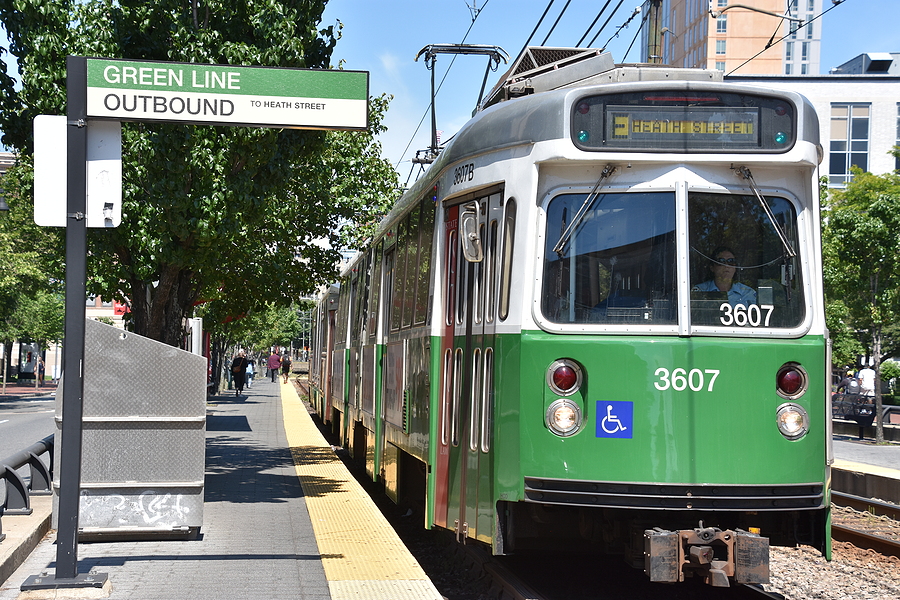The MBTA passes through the campus of Northeastern University.
Part 4: Assessing proposed expansions for Orange and Green Lines
Assessing proposed expansions for Green Line and Orange Line
The previous entry discussed expanding Boston’s T transit system, advocating for completing the Red-Blue connector and extending the Blue Line to Lynn, Cambridge, and the Fitchburg commuter rail line. It proposed filling station gaps on the Red Line, replacing the Mattapan trolley, and potentially extending it to Arlington Heights. To address the Green Line’s slow speed, signal prioritization and stop reductions were suggested, along with an E Line extension to Hyde Square. Reviving the A-line with a dedicated lane and extending it to connect with the Blue Line in Waverley was also proposed, along with potential Orange Line extensions.
Let’s now address the problematic lines, beginning with the Green Line. Notably, the B, C, and E branches are dreadfully slow.
While traffic at intersections is a fact of the Green Line’s light rail nature, signal priority could help mitigate delays. Additionally, many of the stops could be eliminated altogether. For each line, I’ll mention only the stops that should remain.
On the B Line, most stops before Kenmore could be consolidated, leaving only Boston College, Chestnut Hill Avenue, Washington St, Griggs Street, Harvard Avenue, Packard’s Corner, and BU Central stops.
On the C Line, I’d retain only Cleveland Circle, Washington Square, Coolidge Corner, and St. Mary’s Street.
On the Mission Hill branch of the E Line, I’d keep only Back of the Hill, Mission Park, Brigham Circle, and the Museum of Fine Arts on the above-ground section. The Symphony stop could be removed to expedite things, but I’d leave it for now.
Furthermore, an interesting proposal has been to extend the E line to Hyde Square. I’d take this a step further.
The E Line could follow Heath Street, turn onto Walden Street, then onto Centre Street and finally meet up with the Orange Line at Jackson Square.
Stops could be added at the intersections of Heath and Walden and Walden and Centre Street (Hyde Square).
The D Line is mostly fine, being significantly faster than the other branches due to its exclusive right-of-way. However, improvements can still be made.
A brief extension to meet with the Commuter rail Worcester branch at Auburndale (where the right-of-way already exists) could prove beneficial.
Moreover, removing the Beaconsfield stop could speed up the D line at its slowest point. Other than that, for now, these are the only changes I propose.
As for the new Medford extension, I would push the Green Line a bit further down to the West Medford commuter rail station, once again, syncing up with the commuter rail. A stop at Mystic River Parkway seems like a sensible addition.
One of the more significant changes I’d suggest is resurrecting the A Line and allocating it its own lane.
The A Line would branch off from the B Line at Packard’s Corner and continue down Brighton Ave, turn onto Cambridge Street at Union Square Cambridge, continue until Cambridge Street becomes Washington Street, and follow Washington Street until Watertown Yard.
Stops could be added at St. Elizabeth’s Hospital, Oak Square, Waverley Ave (Newton Corner), and, of course, Watertown Yard.
Moreover, the A Line could be extended beyond its historic terminus to meet up with the Blue Line in Waverley.
The Watertown Yard stop could be replaced with a stop at Watertown Square. From there, the A Line could follow Route 20 (Main St) before turning onto Waverley Ave, where a Moxley field stop could be created.
From there, the A Line continues on Waverley Ave until crossing Belmont St onto White St (a stop could be added here as well). From there the A Line would follow White St until Trapelo Road, where it could end at the Waverley (now Blue Line) station.
Orange Line
There’s potential for an additional Green Line extension, but let’s table that for a later discussion. At present, our focus should shift to the expansion of the Orange Line.
The Orange Line is burdened with numerous challenges, not least of which is the heavy traffic on the rail line. Even if these issues were resolved, there would still be significant room for improvement.
The Orange Line could benefit from an extension along the Needham Line beyond Forest Hills, taking over the stops at Roslindale Village, Bellevue, Highland, West Roxbury, and Hersey, all the way to Needham Junction. An infill station at Millennium Park might be a worthy addition too.
While it might initially seem logical to extend the Orange Line along the Needham commuter rail Line to Needham Heights, the numerous old at-grade street crossings between Needham Junction and Needham Heights make this a challenging proposition.
A better approach could be to create a new branch of the D Line of the Green Line, perhaps dubbed the F Line or D2 Line (with Riverside becoming D1). This new branch could split from the D Line between Newton Highlands and Eliot, follow the Newton Falls greenway and old rail right-of-way, and then the Needham commuter rail line, finally converging with the Orange Line terminus at Needham Junction.
This new Green Line branch could replace the existing stops on the Needham Line (Needham Junction, Needham Center, and Needham Heights) and add a station at Newton Upper Falls.
Returning to the Orange Line, extending the northern terminus at Oak Grove through Melrose and into Wakefield isn’t totally necessary, but could be done with relative ease. This would replace the Haverhill commuter rail stops at Wyoming Hill, Cedar Park, Melrose Highlands, and terminate at Greenwood in Wakefield (where the commuter rail could still stop), thereby easing some congestion on the Haverhill line.
Editor’s note: This is the fourth article in a five-part series on fixing the MBTA.

